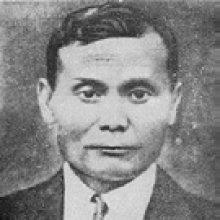Barua: 2 definitions
Introduction:
Barua means something in the history of ancient India, biology. If you want to know the exact meaning, history, etymology or English translation of this term then check out the descriptions on this page. Add your comment or reference to a book if you want to contribute to this summary article.
Images (photo gallery)
India history and geography
Source: What is India: Epigraphia Indica volume XXXI (1955-56)Barua is the name of a river mentioned in inscriptions from Baṅglā (1281 A.D.). The battle referred to in the inscriptions probably lasted only for a day. A large number of soldiers on Vīravarman’s side must also have lost their lives ; but there is no record of that besides vague claims on behalf of the partisans of Gopāla in the records under study. The battle is stated to have been fought on the banks of the river variously called Valuvā, Volukā, Valuā, Valūbā, Vālukā and Valuka which is no other than the modern Barua.

The history of India traces the identification of countries, villages, towns and other regions of India, as well as mythology, zoology, royal dynasties, rulers, tribes, local festivities and traditions and regional languages. Ancient India enjoyed religious freedom and encourages the path of Dharma, a concept common to Buddhism, Hinduism, and Jainism.
Biology (plants and animals)
Source: Google Books: CRC World Dictionary (Regional names)1) Barua in India is the name of a plant defined with Sorghum halepense in various botanical sources. This page contains potential references in Ayurveda, modern medicine, and other folk traditions or local practices It has the synonym Rhaphis halepensis (L.) Roberty (among others).
2) Barua is also identified with Taraxacum javanicum.
Example references for further research on medicinal uses or toxicity (see latin names for full list):
· Monographiae Phanerogamarum (1889)
· Naturaliste Canad. (1984)
· Bulletin of Miscellaneous Information Kew (1935)
· Proceedings of the Biological Society of Washington (1915)
· Species Plantarum
· Proceedings of the Biological Society of Washington (1916)
If you are looking for specific details regarding Barua, for example chemical composition, side effects, pregnancy safety, extract dosage, diet and recipes, health benefits, have a look at these references.

This sections includes definitions from the five kingdoms of living things: Animals, Plants, Fungi, Protists and Monera. It will include both the official binomial nomenclature (scientific names usually in Latin) as well as regional spellings and variants.
See also (Relevant definitions)
Ends with: Dhamarbarua, Dhan-barua, Jhabarbarua, Thabarabarua, Tikanibarua.
Full-text (+4): Dhan-barua, Valuka, Valuba, Valuva, Voluka, Valua, Namgala, Kanhabenna, Kopili, Dendrobium moschatum, Bahadagojatira, Bangla, Theravada, Tanasuliya, Tanasuli, Rhynchostylis retusa, Bhitvara, Davaka, Bhittvara, Zeuxine strateumatica.
Relevant text
Search found 29 books and stories containing Barua; (plurals include: Baruas). You can also click to the full overview containing English textual excerpts. Below are direct links for the most relevant articles:
Satirical works of Kshemendra (study) (by Arpana Devi)
9.2. Summary of the Kānīyā Kīrtan (1861) < [Chapter 1 - Introduction]
9.3. Summary of the Bāhire Rong Chong Bhitore Kowābhāturī (1876) < [Chapter 1 - Introduction]
9.10. Summary of the Ranjan (1927) < [Chapter 1 - Introduction]
The backdrop of the Srikanthacarita and the Mankhakosa (by Dhrubajit Sarma)
Formal Education System in Ancient India (by Sushmita Nath)
The Jagaddala university < [Chapter 3 - Centres of Learning in Vedic and Buddhist Period]
The Nālandā Vihāra university < [Chapter 3 - Centres of Learning in Vedic and Buddhist Period]
The 7th century Valabhī university < [Chapter 3 - Centres of Learning in Vedic and Buddhist Period]
The Catu-Bhanavara-Pali (critical study) (by Moumita Dutta Banik)
(1) The Saranagamana < [Chapter 2 - Subject Matter of the First Bhanavara]
Meaning, purpose, date and authorship of the Catu-Bhanavara-Pali < [Chapter 1 - Introduction]
(5) Isigili Sutta < [Chapter 3 - Subject Matter of the Second Bhanavara]
Vernacular architecture of Assam (by Nabajit Deka)
Development (d): Mongoloid Influence < [Chapter 3]
Tai-Ahom Vernacular Architecture < [Chapter 6]
